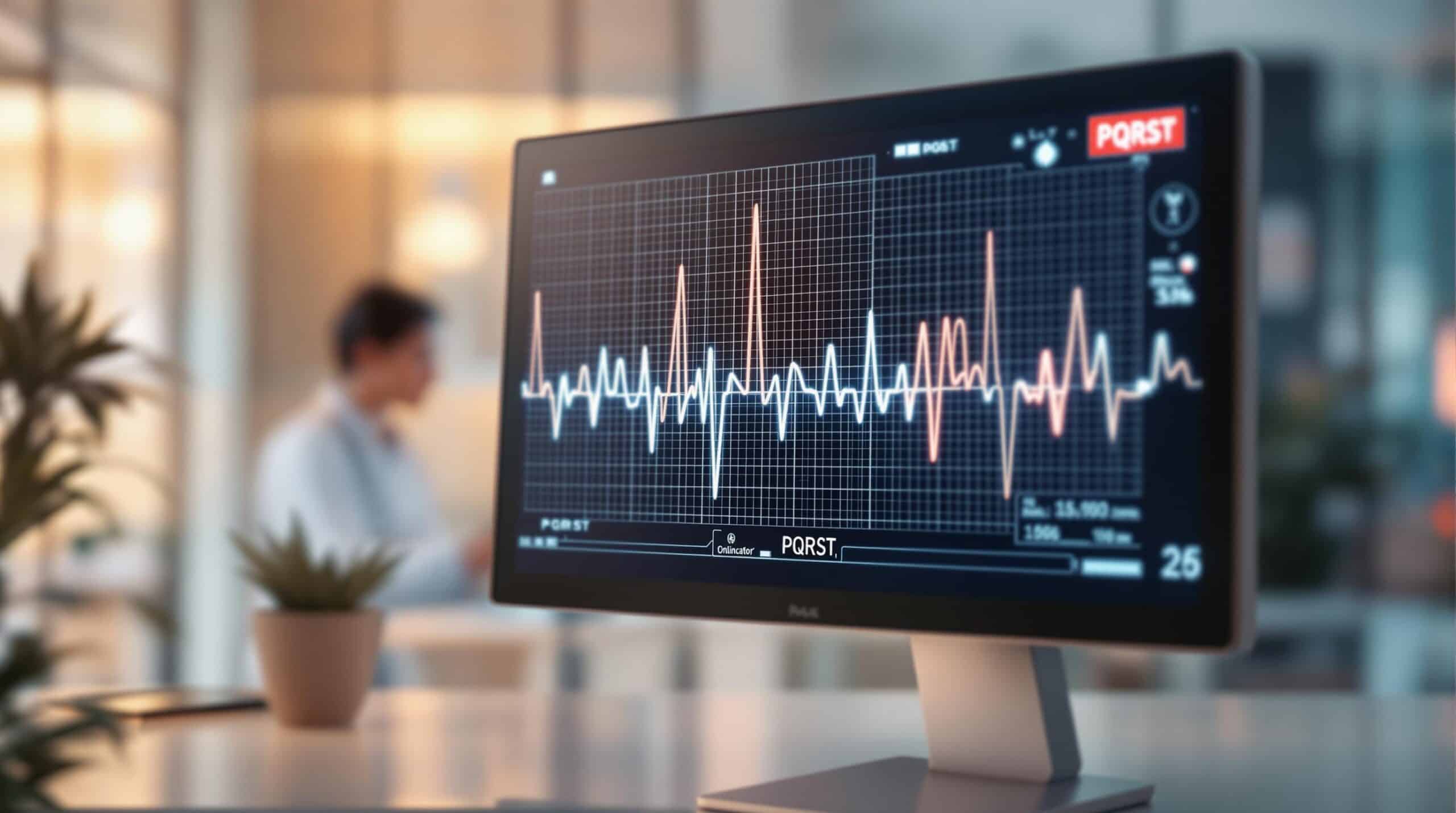The PQRST wave is essential for understanding heart function through an ECG. It represents the electrical activity of the heart during a single heartbeat. Here’s what you need to know:
- P wave: Atrial contraction.
- QRS complex: Ventricular contraction.
- ST segment: Early ventricular recovery.
- T wave: Ventricular relaxation.
Why It Matters:
- Detect cardiac abnormalities.
- Monitor heart health in real time.
- Guide treatment decisions.
Quick Steps for ECG Analysis:
- Identify the P wave.
- Measure the PR interval (0.12–0.20 seconds).
- Examine the QRS complex (duration < 0.12 seconds).
- Check the ST segment for alignment with the baseline.
- Review the T wave for shape and symmetry.
This guide breaks down each component of the PQRST wave and provides actionable tips for accurate ECG interpretation. Read on to refine your skills and confidently analyze heart rhythms.
ECG Interpretation Basics: Understanding PQRST Waves
Understanding the Parts of the PQRST Wave
The PQRST wave is a detailed representation of the heart’s electrical activity. Each part provides specific insights into how the heart functions. Let’s break it down.
P Wave: Atrial Contraction
The P wave is the small upward bump at the start of the ECG cycle. It shows the electrical signal that causes the atria (the heart’s upper chambers) to contract. Normally, the P wave is 2-3 mm tall and lasts 0.06-0.12 seconds [1]. If it looks unusual, it could point to issues in the atria.
QRS Complex: Ventricular Contraction
The QRS complex is the sharp, jagged section of the ECG. It represents the activation of the ventricles (the lower heart chambers). A healthy QRS complex is 5-30 mm tall and lasts 0.06-0.10 seconds [1]. Changes in its size or duration can indicate problems with the ventricles.
T Wave: Ventricular Relaxation
The T wave is a smooth, rounded peak that comes after the QRS complex. It reflects the ventricles recovering and getting ready for the next cycle. Its shape and direction can reveal issues with ventricular health, and abnormalities may suggest serious conditions [2].
PR Interval and ST Segment
The PR interval, lasting 0.12-0.20 seconds, shows the time it takes for the signal to travel from the atria to the ventricles. The ST segment, on the other hand, represents the early phase of ventricular recovery between the QRS complex and the T wave [1].
These elements form the basis for understanding ECG readings, which we’ll dive into further in the next section.
Steps to Read the PQRST Wave on an ECG
Interpreting an ECG requires a structured approach to identify normal rhythms and potential cardiac issues.
How to Analyze the PQRST Wave
Make sure your ECG paper is positioned correctly, then follow these steps:
- Check the P Wave
- Look for upright waves in leads I and II.
- Normal duration: 0.06–0.12 seconds.
- Normal height: 2–3 mm.
- Measure the PR Interval
- Normal duration: 0.12–0.20 seconds.
- Measure from the start of the P wave to the beginning of the QRS complex.
- Use small squares for precision (each square = 0.04 seconds).
- Examine the QRS Complex
- Normal duration: less than 0.12 seconds.
- Assess its width and height.
- Ensure it has a sharp, well-defined appearance.
- Assess the ST Segment
- Look at the segment between the end of the QRS complex and the start of the T wave.
- It should be flat and align with the baseline.
- Review the T Wave
- Check for a rounded, upright shape.
- Ensure it appears smooth and symmetrical.
- Confirm consistency across relevant leads.
Common Abnormal Patterns and Their Meaning
| Pattern | Characteristics | Clinical Significance |
|---|---|---|
| Prolonged PR Interval | Over 0.20 seconds | First-degree AV block [1] |
| Wide QRS Complex | Over 0.12 seconds | Ventricular arrhythmia [3] |
| ST Elevation | Above the baseline | Myocardial infarction [1] |
| T Wave Inversion | Downward deflection | Ischemia or hypertrophy [3] |
Each small square on the ECG paper represents 0.04 seconds (time) and 0.1 mV (voltage). Use this scale to ensure precise measurements. Always interpret any abnormalities within the context of the patient’s overall clinical situation.
For challenging cases, consult references or seek advice from colleagues. Regular practice with different ECG readings will help you gain confidence and improve your skills.
Now that you know how to analyze the PQRST wave, let’s dive into tips for refining your ECG interpretation accuracy.
sbb-itb-aa73634
Tips for Accurate ECG Reading
Interpreting ECGs accurately takes a combination of careful measurement and consistent practice.
Understanding ECG Graph Paper
Accurate ECG interpretation starts with knowing how to use the graph paper. Each small square on the paper equals 0.04 seconds in time and 1 millimeter in voltage. This grid system is essential for measuring the key components of the ECG wave.
To ensure precise measurements:
- Use the isoelectric line as your baseline and count the squares systematically from left to right.
Refer to earlier sections for the normal ranges of the P wave, PR interval, and QRS duration. Once you’re comfortable with these measurements, practice regularly with various ECG readings to sharpen your skills.
Practicing with Different ECG Readings
Memorizing normal values is just the beginning. The real skill lies in recognizing patterns across a range of cases. Building expertise requires exposure to different cardiac rhythms.
Start with normal sinus rhythms to get a clear understanding of standard PQRST wave patterns. Then, gradually move on to more complex cases involving various cardiac conditions.
| Practice Level | Focus Areas | Key Elements to Assess |
|---|---|---|
| Basic | Sinus Rhythm | P waves, regular intervals, normal durations |
| Intermediate | Common Arrhythmias | PR intervals, QRS variations, ST segments |
| Advanced | Complex Patterns | Multiple lead interpretation, subtle abnormalities |
When practicing, focus on one component at a time rather than trying to interpret the entire ECG at once. This step-by-step approach helps you avoid feeling overwhelmed and ensures a detailed analysis of each wave.
Take your time measuring intervals and avoid rushing to conclusions. For tough cases, break your analysis into smaller steps:
- Check the overall rhythm for regularity.
- Compare your findings to normal ranges and note any deviations.
This methodical process will help you build confidence and accuracy over time.
Resources to Improve ECG Skills
Once you’ve grasped the basics of ECG interpretation, the right resources can help you refine your skills and build confidence.
Online Learning Platforms
ACLS Medical Training provides in-depth ECG modules tailored for healthcare professionals. These modules cover everything from basic principles to more advanced interpretations [4].
Nurse Cram specializes in NCLEX prep with a focus on ECG-related content. Their offerings include:
- Scenario-based exercises for analyzing PQRST waves
- Clinical case studies featuring common cardiac rhythms
- Practice questions with detailed explanations
Learning Tools and Study Materials
A mix of traditional and digital tools works best for mastering ECG interpretation:
| Resource Type | Features | Purpose |
|---|---|---|
| Study Guides | Detailed rhythm breakdowns, exercises | Structured learning |
| Digital Tools | Simulation apps, software | Hands-on practice |
| Clinical References | AHA guidelines, ECG standards | Staying up-to-date |
The ECG/EKG Interpretation Study Guide by Nurse Sarah is a go-to for foundational practice materials [3]. For those starting out, Basic ECG Interpretation guides provide a clear focus on PQRST wave patterns, making it easier to build a strong base before tackling more complex readings [1].
Nurse Cram NCLEX Exam Review

Nurse Cram’s platform includes NGN-style ECG practice questions and scenario-based exercises. These resources are designed to enhance critical thinking during cardiac assessments while preparing for the licensing exam.
Conclusion: Building Confidence in PQRST Wave Reading
Interpreting ECGs accurately is a key skill for assessing and treating patients effectively. To gain confidence, focus on consistent practice and understanding what each wave represents. The PQRST components highlight specific heart functions: P wave for atrial contraction, QRS complex for ventricular depolarization, and T wave for ventricular relaxation.
Here are some practical ways to sharpen your ECG interpretation skills:
| Focus Area | Method and Outcome |
|---|---|
| Daily ECG Sample Review | Quickly spot normal and abnormal patterns |
| ECG Graph Paper Practice | Improve accuracy in measuring intervals and segments |
| Case-based Scenarios | Link ECG findings to real patient conditions |
Critical thinking is just as important as practice. Instead of memorizing patterns, focus on why changes occur and what they mean for patient care. This mindset helps you recognize and address cardiac abnormalities more effectively.
Improving ECG skills takes time and exposure to a variety of cardiac rhythms. Structured learning tools and resources can make the process smoother. Combine theoretical knowledge with hands-on practice to ensure accurate, timely cardiac assessments. Staying informed about updated ECG guidelines will also help you maintain expertise in PQRST wave interpretation.
FAQs
How do you read the PQRST wave?
To interpret the PQRST wave, follow these steps:
- Identify each part: Look for the P wave, QRS complex, ST segment, and T wave in sequence.
- Check durations: Measure the duration of each component and compare them to normal ranges.
- Calculate heart rate: Count the number of R waves in a six-second strip and multiply by 10.
Rather than just memorizing numbers, focus on spotting patterns and how the components relate to each other. This method helps in recognizing both normal rhythms and any irregularities during clinical evaluations [1][2].
What are the 4 main waves on an ECG?
The ECG has four key components: the P wave, QRS complex, ST segment, and T wave. Each one tells a story about the heart’s activity:
- P wave: Signals atrial activity.
- QRS complex: Represents ventricular contraction.
- ST segment: Shows early ventricular recovery.
- T wave: Indicates ventricular relaxation.
Knowing what each wave represents and how they interact is essential for spotting heart issues and making informed decisions in a clinical setting [1][2].
Regular practice with different ECG readings can help healthcare professionals build confidence in identifying both normal patterns and abnormalities.
Related posts
- How to Master NCLEX Priority Questions: Step-by-Step Guide
- Ultimate Guide to Evidence-Based Practice for NGN NCLEX
- NGN Case Studies: Spotting Key Clinical Cues
- 6 Clinical Judgment Skills for Analyzing Patient Data

Mia is dedicated to helping nursing students and new graduates confidently prepare for the Next Generation NCLEX exam. With a focus on providing clear, actionable advice and support, Mia offers practical study tips, effective strategies, and encouragement to guide you through the complexities of nursing exams. Whether you need help mastering question formats, managing stress, or creating a personalized study plan, Mia is here to ensure you feel prepared and empowered every step of the way.

